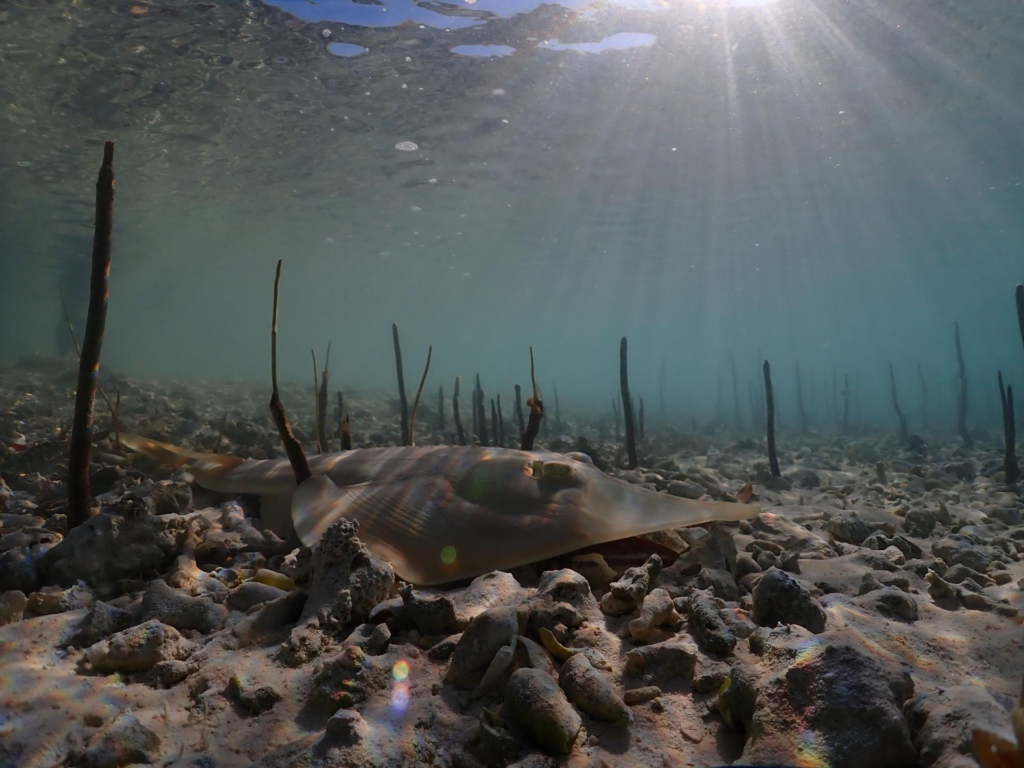Red Sea Global shares update on wildlife protection initiatives

“Nature is our most valuable asset. That is why we have set ourselves the target of achieving a 30% net conservation benefit by 2040, by enhancing biologically diverse habitats including mangroves, seagrass, corals, and land vegetation, as well as protecting our vital species,”
said Dr Omar Al Attas, Head of Environmental Protection and Regeneration at Red Sea Global.
“To mark International Day of Biological Diversity 2024, we are sharing our latest scientific findings for four critical species who call our destination home, and explaining how we are working to not only protect them, but where possible encouraging them to flourish.” he added.
Halavi guitarfish
Halavi guitarfish are a critically endangered species, meaning they are considered to have ‘an extremely high risk of extinction in the wild’. RSG discovered that the Al Wajh lagoon in The Red Sea destination is a stronghold for this species.
Last year it successfully campaigned for Al Wajh Lagoon to be designated an ‘Important Shark and Ray Area’ (ISRA) by the International Union for Conservation of Nature (IUCN), highlighting the lagoon’s significance for the reproduction of Halavi guitarfish. This makes it one of only three such ISRAs for this species globally.
The developer is now extending its work to systematically assess the species’ distribution and movement patterns, using acoustic tags and receiver networks.
Dugong
Dugong are a threatened species and, ecologically, highly distinctive. There is no other similar species in the region. Dugong are a difficult species to manage as they are rare and can be incredibly shy.
RSG’s scientists have spotted them in several places throughout The Red Sea and AMAALA areas and are now working to improve their understanding of the dugong’s foraging areas and migratory pathways to be better able to protect them. The developer is employing a variety of methods to find them, including drones, and are now exploring the use of machine learning to help identify potential sightings in large-scale aerial surveys.
With proper protection, RSG believes its destinations can become a regionally significant location for the dugong thanks to the many sheltered shallow seagrass areas, which are their preferred type of feeding ground.
Turtles
There are five species of sea turtle found in the Red Sea. Of these, two species have been recorded nesting along the Saudi Arabian Red Sea coast: the Green and Hawksbill turtles. Green turtles are listed as endangered, while Hawksbill turtles are listed as critically endangered on the IUCN Red List.
Since 2021, RSG has responded to nine turtles with floating syndrome, an issue that arises for various reasons, which leaves them at the surface unable to dive. While at the surface they are at higher risk of boat strikes, vulnerable to predators, unable to feed, and will gradually become dehydrated.
Of the nine turtles RSG has responded to, eight have been Hawksbills. Three of the turtles rehabilitated by RSG in collaboration with the National Center for Wildlife and the Fakieh Aquarium have been satellite tagged to track their progress following rehabilitation.
Sooty falcons
The Sooty falcon is one of the charismatic bird species found along the Red Sea coast, but globally is vulnerable to extinction. It nests only in the Middle East and some regions of north-east Africa. RSG is helping the Sooty falcon with nesting by trialing different artificial nest designs using locally sourced materials. Last year, three chicks were successfully reared in one of its nest boxes, the first successful use of artificial nest boxes for this species anywhere in the world. RSG expects more of the nests to be used in the coming season and beyond as new pairs seek suitable nesting sites.
Ongoing monitoring of population size and breeding success has been established, which includes GPS and satellite tagging of more than 30 Sooty falcons to better understand their migratory and hunting patterns.
Responsible development
In 2023, The Red Sea welcomed its first guests, with three of its hotels now open. The Red Sea International Airport (RSI) has been receiving a regular schedule of domestic flights since September 2023 and international flights began in April 2024, marking the start of a new twice-weekly route between The Red Sea and Dubai International. Desert Rock and Shebara will welcome first guests later this year, while Shura Island is on track to welcome guests in 2025.
The Red Sea destination is powered off-grid with 760,000 panels already installed, and one of the world’s largest battery storage facilities already built and operational.




 Email: info@cyber-gear.com
Email: info@cyber-gear.com